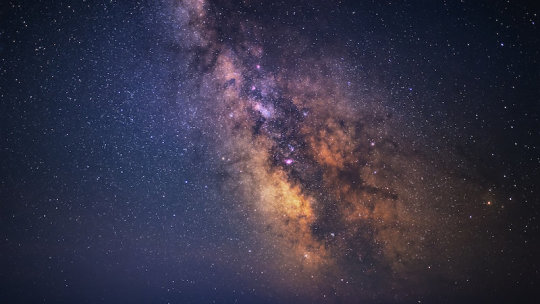[ad_1]
Published in Nature today, scientists have shown how this hourglass-like feature, which dwarfs all other radio structures in the Galactic Centre, is likely the result of a phenomenally energetic burst that erupted near the Milky Way’s supermassive black hole a few million years ago.
Using the South African Radio Astronomy Observatory (SARAO) MeerKAT telescope, Ian Heywood of the University of Oxford’s Department of Physics and his colleagues mapped out broad regions in the centre of the galaxy, conducting observations at wavelengths near 23 centimetres. Radio emission of this kind is generated in a process known as synchrotron radiation, in which free-floating electrons are accelerated as they interact with powerful magnetic fields. This produces a characteristic radio signal that can be used to trace energetic regions in space. The radio light seen by MeerKAT penetrates the dense clouds of dust that block visible light from the centre of the galaxy.
Lead author Dr. Heywood, who processed the large amount of observational data which led to this result, said: ‘The centre of our galaxy is relatively calm when compared to other galaxies with very active central black holes. Even so, the Milky Way’s central black hole can become uncharacteristically active, flaring up as it periodically devours massive clumps of dust and gas. It’s possible that one such feeding frenzy triggered powerful outbursts that inflated this previously unseen feature.’
By examining the nearly identical extent and morphology of the twin bubbles, the scientists believe they have found convincing evidence that these features were formed from a violent eruption that over a short period of time punched through the interstellar medium in opposite directions.
MeerKAT has unprecedented sensitivity and imaging capabilities which, coupled with its geographic vantage point for observing the Galactic centre, has resulted in the clearest ever image of the radio waves emanating from the centre of the Milky Way, a part of the sky that is notoriously difficult to image at such wavelengths.
These new observational capabilities are unlocking a “fossil record” which allows scientists to piece together the history of the Galactic centre and the supermassive black hole that lurks there. Although the structure is likely to be a few million years old it is still possible to observe it, and from there scientists can infer from where it came.
Head of Astrophysics at the University of Oxford, Professor Steve Balbus, said: ‘It is extremely exciting to be able to peer at the centre of the Galaxy with such high definition and precision. This is the nearest supermassive black hole to us in the Universe, and MeerKAT has provided us with front row centre seats. We are going to learn an enormous amount about how black holes feed themselves and how they influence their environments. In the relatively brief time that MeerKAT has been up and running, the science that the team at Oxford has already produced has been transformational. Oxford can be rightly proud of their leadership involvement with the MeerKAT Project, and I personally can’t wait to see what more there is to come — this is only the beginning of a new era in radio astronomy.’
Co-author, William Cotton, from the National Radio Astronomy Observatory in Charlottesville, Virginia, said: ‘The shape and symmetry of what we have observed strongly suggests that a staggeringly powerful event happened a few million years ago very near our galaxy’s central black hole. This eruption was possibly triggered by vast amounts of interstellar gas falling in on the black hole, or a massive burst of star formation which sent shockwaves careening through the galactic centre. In effect, this inflated energetic bubbles in the hot, ionized gas near the galactic centre, energizing it and generating radio waves which we could eventually detect here on Earth.’
The event, reported today in Nature, could also be the origin of the population of electrons that are required to power the radio emission from mysterious magnetised filaments. These thread-like structures have been seen nowhere but in the Galactic centre, and there has been no definitive explanation for their origin since they were first discovered 35 years ago. “Almost all of the more than one hundred filaments are confined by the radio bubbles,” said co-author Prof. Farhad Yusef-Zadeh of Northwestern University in Evanston, Illinois.
Co-author Fernando Camilo of SARAO in Cape Town, said: ‘These enormous bubbles have until now been hidden by the glare of extremely bright radio emission from the centre of the galaxy. Teasing out the bubbles from the background ‘noise’ was a technical tour de force, only made possible by MeerKAT’s unique characteristics and propitious location in the Southern hemisphere. With this unexpected discovery we’re witnessing in the Milky Way a novel manifestation of galaxy-scale outflows of matter and energy, ultimately governed by the central black hole.’
Today’s result cements the great “discovery machine” potential of the new generation of radio telescopes as we move towards the construction of the Square Kilometre Array.
Story Source:
Materials provided by University of Oxford. Note: Content may be edited for style and length.
[ad_2]















